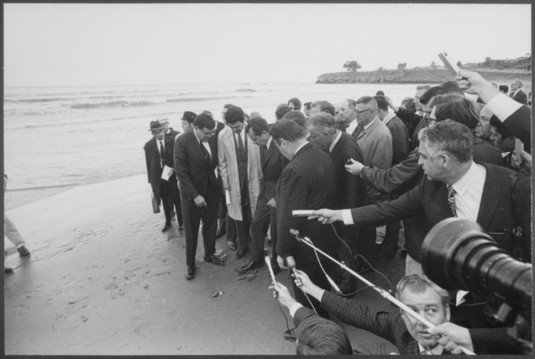Green Talks
Looking Behind the Scenes of Environmental Journalism
By Maximilian Feichtner, Jonas Stuck, and Ayushi Dhawan
“I got an anonymous call. For some reason I thought it was one of the workers out at the platform. I answered the phone and they said something like, ‘The ocean is boiling. The bottom of the ocean exploded’,” said Bob Sollen, former Santa Barbara News-Press reporter. On 28 January 1969, a disastrous leak at the Union Oil well led to a massive oil spill off the coast of Santa Barbara; an estimated 11 million liters of crude oil was spewed into the ocean, creating an oil slick 56 kilometers long along California’s coast and killing thousands of birds, fish, and sea mammals. Bob Sollen broke the story and the Santa Barbara oil spill became national news and the first oil spill to be televised and brought to the screens of family homes. Images of oil-covered beaches and dead birds outraged and sickened viewers across the country. The oil spill not only mobilized people to think about the environment differently—not from an economical, but an environmental point of view—it also sparked environmental policy change in Washington, DC, and led to the creation of the much-celebrated Earth Day in the 1970s.

President Richard Nixon on the oiled Santa Barbara beach, with reporters. Photo: U.S. National Archives and Records Administration via Wikimedia Commons, public domain.
The relationship between the rise of the ecological beat and the rise of environmental journalism since the 1970s has been a complicated one. At particular moments in time, anxieties have risen among those reporters covering issues like endangered species, dioxins, smog, the export of hazardous waste, and nuclear fallouts. They have written compelling stories about the state of the environment for the public sphere time and time again. So is journalism all about covering interesting stories, exposing scandals and wrong-doers? As Alison Anderson pointedly remarks, environmental reporting thrives on dramatic “events” involving “goodies” and “baddies.” But one has to ask, is that enough to shed light on complex environmental issues and bring about environmental change?
Ever since the beginning of environmental journalism, environmental problems have remained part of media culture, but in recent years the environmental beat has been contested and reconfigured. Some of the daily struggles that such journalists face are the shrinking news space in traditional media outlets for environmental issues, environmental subjects being riddled with scientific data and jargon, a lack of training, short attention spans of news consumers, restrictive access to government data on environmental conservation, as well as death threats. These challenges, however, do not undermine the ability of environmental journalists to provide narratives of hope through creating collective dialogues on issues of public concern, narratives that not only affect the thinking of readers but also empower them. In 2017, Bobby Magill, President of the Society of Environmental Journalists, stated that “the need for environmental journalism is more acute now than ever. Without journalists and environmental journalism the public would have a very difficult time trying to parse out the facts versus misinformation regarding the environment in which they live.”
As scholars in the environmental humanities, we come across articles by journalists on a daily basis, and as textual resources, they are sometimes the only or most reliable source of information on a particular issue. In this blog series, Green Talks, we look behind the scenes of environmental reporting.
In the first installment, “Barbro Soller and the Emergence of Modern Environmentalism in 1960s Sweden,” historian David Larsson Heidenblad offers a compelling account of the crucial role of journalists in putting environmental crises on the public agenda. He does so by tracing the breakthrough of environmental journalist Barbro Soller with her publications on domestic and industrial pollution in Sweden. This example also shows the potential to advance the historiography of modern environmentalism by shedding light on groundbreaking environmental journalists who wrote for change.
As a journalist and researcher on journalism herself, Rosalind Donald explores “Beyond Denial and Anger: How Journalists and Scientists can Collaborate for better Communication” in the second installment of the series. Breaking down complex research findings and translating often highly specialized language makes communicating science a huge feat and presents pitfalls for both journalists and scientists alike. That is why Rosalind Donald calls on us to team up and work together! Not only in times of rising awareness on climate change do we all need ways to access comprehensive and comprehensible information on scientific studies—environmental journalism can play a crucial role here.
Making visible the often hidden complexity of socio-environmental phenomena lies at the heart of the third installment: “Picturing Complexity: Environmental Photojournalism in the Twentieth Century.” Environmental historian Anna-Katharina Wöbse explores how photography, environmental awareness, and technological features for cameras co-evolved to play a crucial role in setting the environmental agenda worldwide. She traces the history of environmental photojournalism from oiled birds in the North Sea in iconic black and white pictures to contemporary stories of pollution and plastic contamination. Pictures say more than a thousand birdsongs.
In the final installment of the series, “On Canoes, Pine Trees and Volcanoes: The Importance of Eyewitness Observation in Environmental Journalism,” journalist and journalism teacher Mark Neužil gives very personal insight on the importance of attentive observation in writing environmental stories. This advice is even more relevant in times when much of a reporter’s interactions with interviewees and the (natural) world is mediated by telephone and digital mediums. Writing well and reporting the facts are the other two essential features of environmental journalism. But without curiosity, an environmental story can never be comprehensive. Investigative journalism can be dangerous now as it was in the past—if it were otherwise, Pliny the Elder might not have died more than 2000 years ago.
Environmental Journalism plays a crucial role in uncovering and communicating gloomy as well as positive stories about the environment. Media tells its audiences not necessarily how, but rather what to think about, especially when it comes to complex environmental topics. As researchers, we need to critically reflect on the processes that lead to and enable such agenda-setting, as well as on single journalistic stories. Media coverage translates into public concern and political agendas—and vice versa—in complex ways. These processes are not only influenced by public concerns or the dimensions of environmental issues, but also depend on the interests of the owner of a certain news outlet, political and corporate lobbying, and last but not least how compelling a certain story can be made. Weighing the constraints and opportunities of (investigative) media reports makes these sources even more valuable to researchers—especially when it comes to controversial socio-environmental topics that state or corporate actors would rather keep hidden. In this sense, join us on our journey: with every installment of this blog series, we will discover how important it is to put the environment on the public agenda, whether it be the dramatic boiling ocean during the Santa Barbara oil spill or the countless, less obvious, cases of environmental trouble.







